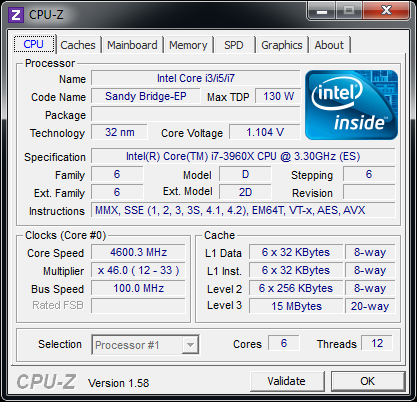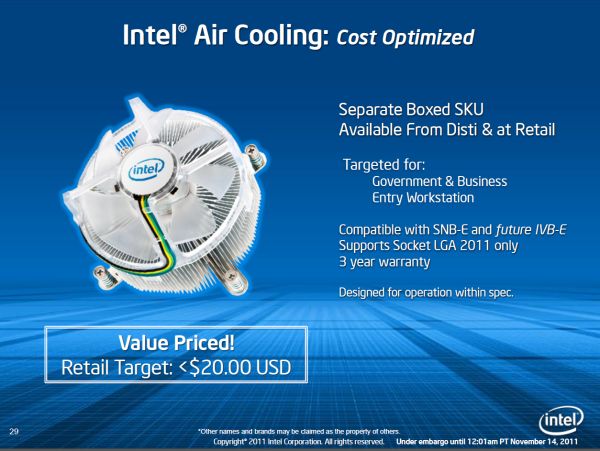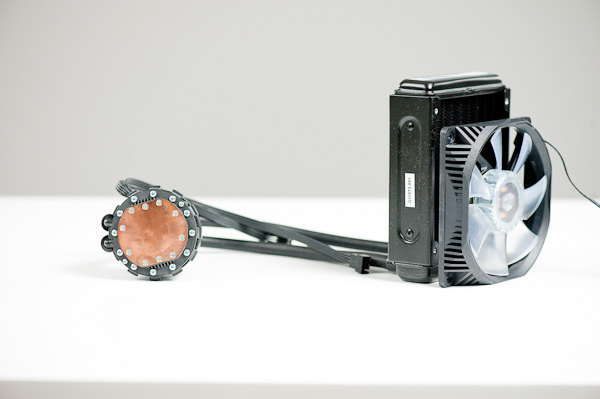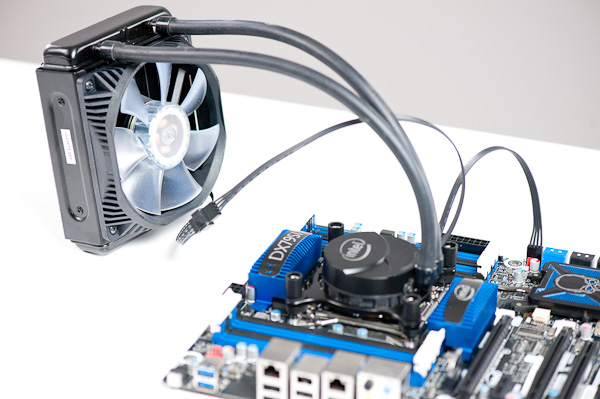Intel Core i7 3960X (Sandy Bridge E) Review: Keeping the High End Alive
by Anand Lal Shimpi on November 14, 2011 3:01 AM EST- Posted in
- CPUs
- Intel
- Core i7
- Sandy Bridge
- Sandy Bridge E
Overclocking
Sandy Bridge brought the motherboard's clock generator onto the 6-series chipset die. In doing so, Intel also locked its operation to 100MHz. While there was a bit of wiggle room, when combined with a locked processor, Intel effectively killed overclocking with most lower end Sandy Bridge chips.
For its more expensive CPUs, Intel offered either partially or fully unlocked (K-series) CPUs. The bus clock was still fixed at 100MHz, but you could overclock your processor by increasing its clock multiplier just like you could in the early days of overclocking.
With Sandy Bridge E, overclocking changes a bit. The clock generator is still mostly impervious to significant bus clock changes, however you're now able to send a multiple of its frequency to the CPU if you so desire. The options available are 100MHz, 125MHz, 166MHz and 250MHz.
Once again, wiggle room at any of these frequencies is limited so don't think we've moved back to the days of bus overclocking. You do get a little more flexibility, particularly with partially unlocked CPUs, but otherwise SNB-E overclocking is hardly any different from its predecessor.
Note that even if you select any of these options, the rest of the system still operates within spec. The multiplied bus clock is only fed to the CPU.

With a bit of effort I had no problems hitting 4.6GHz on my Core i7 3960X review sample. I had to increase core voltage from 1.104V to 1.44V, but the system was stable. While I could get into Windows at 4.8GHz and run a few benchmarks, the system wasn't completely stable.
No Cooler Included
None of the retail or OEM SNB-E parts include an Intel cooler in the bundle, a significant departure from previous CPUs. Presumably the cost of bundling a beefy cooler with these parts would've driven prices higher than Intel would've liked (remember you are getting a much larger die for roughly the same price as the outgoing Core i7 990X). Intel can also rationalize its decision against including any sort of cooler in the retail box by looking at the fact that many enthusiasts at this level opt for aftermarket cooling regardless.
Intel hasn't completely left SNB-E cooling up to 3rd party vendors however. There are two official Intel coolers available for use with SNB-E. The first is a < $20 heatsink that looks a lot like Intel's current coolers but with a couple of modifications (clear fan/shroud, retention screws instead of pegs). Intel states that this cooler is designed for operation within spec, meaning it could possibly limit overclocking attempts.

If you want an Intel branded overclocking solution, there's the RTS2011LC:

This is a closed loop liquid cooling solution similar to what AMD introduced alongside its Bulldozer CPU and similar to what many 3rd party cooling companies already offer. Intel expects its liquid cooling solution to be priced somewhere in the $85 - $100 range.
These closed loop liquid coolers are great primarily for getting away from the tower-of-metal heatsinks that have grown in popularity over the past several years. The radiator is a too small to compete with more traditional water cooling systems, but it can be a good gateway drug for the risk averse.











163 Comments
View All Comments
yankeeDDL - Monday, November 14, 2011 - link
That's what I was doing: blaming AMD. Intel is doing what any company that is interested in making money/profit would do.yankeeDDL - Monday, November 14, 2011 - link
Sorry ... I replied to the wrong post :) I meant to hit the one below!JlHADJOE - Tuesday, November 15, 2011 - link
If you compare it to the extreme edition chip, then Bulldozer looks like good value. But then the 3960X is a halo model for those people who care nothing about price.Considering the 3930K gives you 95% the performance of the 3960X for 50% of the price (see xbitlabs), there's really no reason to get the X-edition chip unless you are building a system purely for bragging rights.
Now when compared to the 3930K, the FX8150 doesn't look nearly as good. If we consider total platform costs with either system having a $300 motherboard and $200 in ram, then we're looking at something in the region of $750 for BD, vs $1000 for the SB-E. +$250 is small change for double the performance at a similar power envelope.
yankeeDDL - Tuesday, November 15, 2011 - link
JIHADJOE, yes, that was my point.The 3960X is -arguably- the fastest CPU available, but it is faster by a tiny margin, while being radically more expensive than anything else.
So yes, nothing looks as bad in terms of price/performance ratio, not even the FX8150. And that's, basically, bad for everyone (except Intel)
actionjksn - Monday, November 14, 2011 - link
I agree too AMD's poor Bulldozer performance is having a huge effect on what we can get from Intel and at what price. And I blame AMD not Intel, because Intel or any other company is supposed to do what's best for their company. Heck if Intel did what we want they would probably cause serious harm to AMD. Because it would make AMD even less competitive. And I don't think Intel really wants to put AMD out of business.yankeeDDL - Monday, November 14, 2011 - link
That's what I was doing: blaming AMD. Intel is doing what any company that is interested in making money/profit would do.GeorgeH - Monday, November 14, 2011 - link
One of the bigger advantages of this platform to me is the 8 DIMM slots. However it was rumored that the first revision of SB-E had/has VT-D problems, which spoils things a little bit as VMs are one of the bigger reasons for lots of RAM. Can you confirm or deny if there are VT-D issues?Anand Lal Shimpi - Monday, November 14, 2011 - link
VT-d is supported, checking to see if there are any functional issues now.Take care,
Anand
GeorgeH - Monday, November 14, 2011 - link
ArsTechnica is reporting that VT-D is broken, but they don't cite any sources. A short article explaining what VT-D is for those who don't know and what (if anything) is broken might be in order.Filiprino - Monday, November 14, 2011 - link
That thing is really big!As for Quick Sync, it's not really useful. If you want quality you'll have to use x264, and with lower qualities x264 has some presets that are near as fast as Quick Sync.
The winner combo is LGA2011+Kepler/Souther Islands.
If you have a hole in your pocket you can throw in a dual socket motherboard, some liquid cooling and a big SSD.